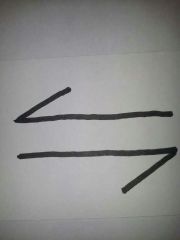![]()
![]()
![]()
Use LEFT and RIGHT arrow keys to navigate between flashcards;
Use UP and DOWN arrow keys to flip the card;
H to show hint;
A reads text to speech;
17 Cards in this Set
- Front
- Back
- 3rd side (hint)
|
What is a mole? |
A unit used in chemistry to measure amounts of substances on a large scale |
|
|
|
What relates moles and relative atomic mass? |
One mole of an substance is equal to its relative atomic mass in grams |
|
|
|
What relates moles and relative formula mass? |
One mole of substance is equal to its relative formula mass in grams |
|
|
|
What is empirical formula? |
The simplest whole number ratio of Atoms of each element in a compound individually |
e.g. C2H4 becomes CH2 |
|
|
How do you work out the empirical formula of a compound? |
Relative formula mass÷ Relative atomic mass of each element in the compound. Then simplify the ratio by dividing by the smallest result |
|
|
|
If the ratio is not an integer, what do you do? |
Multiply both sides by the same number in order to make them both integers |
|
|
|
What is yield? |
The amount of products that are created by the reactants |
|
|

What does this symbol mean? |
It is a reversible reaction (products are turned into reactants) |
|
|
|
Why does the products mass not always equal the reactants? |
1. Some products may be lost when separated from reactant mixture 2. Reaction may be reversible 3. Reactants may react different to how is expected |
|
|
|
What is the formula for percentage yield? |
(Amount produced÷ Max amount possible) x 100 |
|
|
|
Give four main ways of measuring rates of reaction |
1. Measuring gas given off 2. Measuring Reactants mass loss 3. Time taken to disappear 4. Time taken for cross to disappear |
|
|
|
What are the two formulas for rate of Reaction? |
1. Amount of reactant used÷ time taken for reaction to be completed 2. Amount of product formed÷ Time taken for reaction to be completed |
|
|
|
What is activation energy? |
The minimum amount of energy required for reaction to take place when particles collide |
|
|
|
How do the concentration, temperature, pressure and surface area affect the rate of Reaction? |
As any of these factors increase, so does the rate of reaction |
|
|
|
What are catalysts? |
Substances that speed up reactions but remain unchanged themselves |
|
|
|
Give four pros of using catalysts |
1. Less energy is used 2. Speeds up reactions 3. Reusable 4. Lower production costs |
|
|
|
Give two cons of using catalysts |
1. Can be toxic 2. Can be expensive |
|

